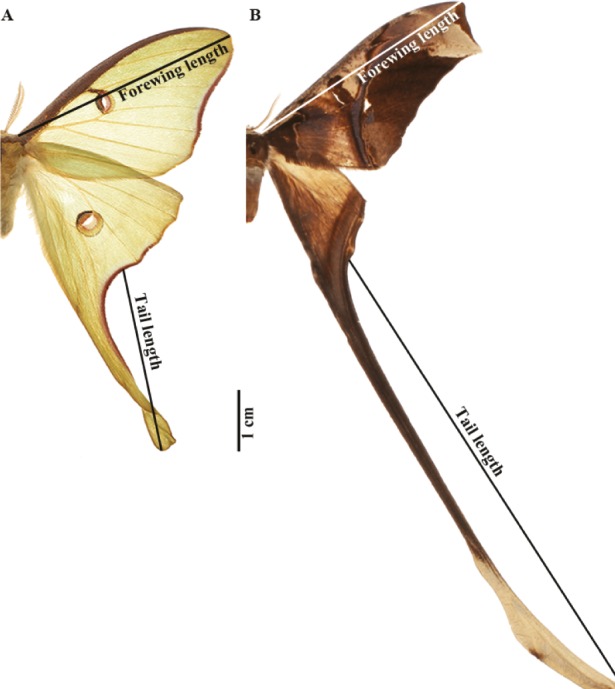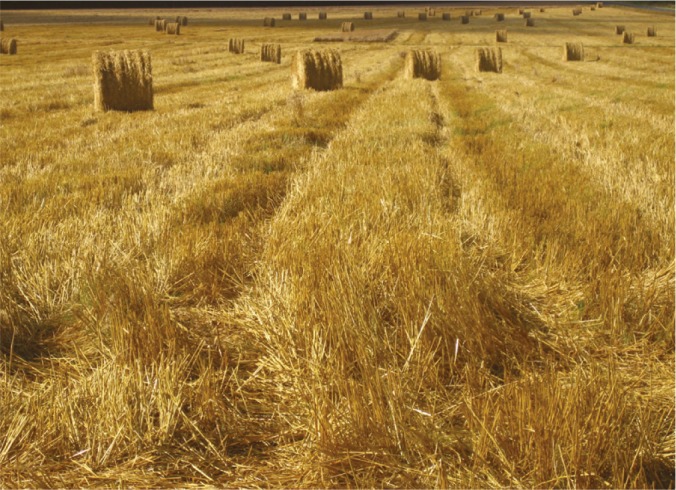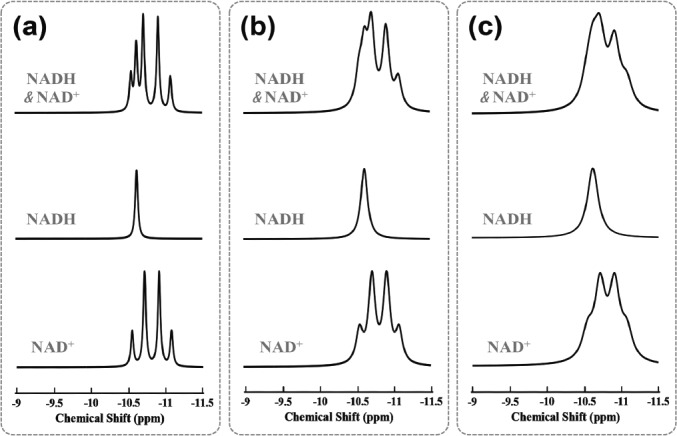Bat echolocation and luna moth tails

Forewing and tail length measurement protocol for Actias luna (A) and Copiopteryx semiramis (B).
Diversionary tactics, such as false eye spots, are a common predator avoidance mechanism for many prey species, but it is unclear whether species that fall prey to bats engage in the acoustic equivalent of such visual deflection. Jesse Barber et al. (pp. 2812–2816) observed interactions between big brown bats and luna moths to determine whether the moths’ long, spinning hindwing tails serve to disrupt the bats’ echolocation. The authors tethered luna moths using fishing line and removed the tails from half of the moths. High-speed, infrared-sensitive cameras and ultrasonic microphones captured bat behavior and predation success. Luna moths with tails experienced a 47% survival advantage over moths without tails, similar to the survival advantage experienced by moths with bat-detecting ears. Bats targeted the tail section of tailed moths during 55% of interactions, suggesting that the tails may somehow lure the bats to the nonessential appendages. Phylogenetic analysis suggests that long moth tails evolved multiple times in the Saturniidae family of moths, further suggesting that the tails may be advantageous to moth species as a tool for predator avoidance. — J.P.J.
Influenza transmission and surveillance
The incidence of influenza outbreaks around the world has traditionally been tracked by compiling doctors’ reports of patients’ symptoms. Recently, algorithms have been developed to estimate cases of influenza by tracking individuals’ Google searches related to the disease. However, both surveillance methods fail to capture the actual number of influenza cases during an outbreak. Wan Yang et al. (pp. 2723–2728) used data assimilation methods to generate a precise estimate of influenza cases, including unreported infections, during outbreaks in 115 cities in the United States between 2003 and 2013. The technique yielded information on epidemiological parameters including population susceptibility, basic reproductive number for influenza infection, attack rate, and infectious period that correlated with past studies using alternative methods. The authors also found that the portion of the population that became infected during the 2009 flu pandemic was approximately 27%, which is higher than all other flu seasons during the decade examined. Desert cities in the southwestern United States also displayed different trends in the basic reproductive number for influenza infection than other cities, suggesting that climate conditions may influence influenza transmission. According to the authors, the data assimilation and modeling techniques may provide insights into seasonal and pandemic influenza transmission patterns that improve upon clinical and online surveillance data alone. — J.P.J.
European crop yields and changing climate

Wheat stalks near Sézanne, France, in 2007. Image courtesy of Wikimedia Commons/Meena Kadri.
Wheat and barley crop yields have stagnated in Europe since the early 1990s, coinciding with a warming growing season, but it is uncertain whether there may be a cause-and-effect relationship between the crop yields and climate. Frances Moore and David Lobell (pp. 2670–2675) developed a statistical test to detect whether climate trends have influenced crop yields. The authors found that long-term changes in temperature and precipitation trends since 1989 reduced wheat yields by 2.5% and barley yields by 3.8% on average across Europe. The climate trends also slightly increased maize and sugarbeet yields on average across the continent. Impacts on yields varied widely across Europe, with the Mediterranean experiencing higher yield reductions than average for most crops. According to the authors, climate trends account for 10% of wheat and barley yield stagnation in Europe, suggesting that the majority of impacts on yield may be due to factors including changes in agricultural and environmental policies. — J.P.J.
Designing effective HIV vaccines
HIV vaccine design efforts have been hampered by the ability of the retrovirus to integrate its genes into host DNA, suppress immunity, and generate variants that evade immune control. Recent failed clinical trials suggest that an ideal HIV vaccine would likely generate an antiviral humoral response while preventing T cells from promoting infection. Timothy Fouts et al. (pp. E992–E999) describe an HIV vaccine that protects rhesus macaques against simian immunodeficiency virus (SIV) and a laboratory-created combination of the SIV and HIV viruses known as SHIV. The authors created the vaccine by stably expressing a highly conserved transition-state structure that is normally exposed on glycoprotein gp120 during viral entry. The single-chain gp120-CD4 chimeric subunit protein vaccine elicited heterologous protection against SHIV or SIV in three independent rhesus macaque studies after repeated low-dose rectal exposures to SHIV162P3 or SIVmac251. Vaccine protection was observed in an optimal zone defined by strong antibody responses and modest T-cell responses to the HIV envelope glycoprotein; protection was lost in the presence of heightened T-cell responses, low antibody titers, or both. According to the authors, the findings suggest that balance between an antibody response and antigen-specific T-cell activation is critical to vaccine-mediated protection against HIV. — A.G.
Measuring NAD+ and NADH in the human brain

Magnetic resonance spectra of NAD+ and NADH at resonance linewidths of 8 Hz (A), 16 Hz (B), and 24 Hz (C).
Nicotinamide adenine dinucleotide (NAD) is an essential metabolite found in living cells, where it plays crucial roles in producing ATP and modulating signaling pathways that regulate aging and cell death. The ratio of oxidized (NAD+) to reduced (NADH) forms of the metabolite is linked to a range of diseases, but methods to accurately quantify these molecules in vivo are lacking. Xiao-Hong Zhu et al. (pp. 2876–2881) developed a noninvasive technique that employs high-field magnetic resonance (MR) to measure intracellular levels of NAD+ and NADH in the human brain. The authors generated a model that predicts the 31P spectroscopic characteristics of NADH and NAD+, enabling the resolution of overlapping spectra of these two molecules when MR measurement is performed at high-field strengths. Using this method, the authors quantified NAD+ and NADH in the brains of 17 healthy human participants ranging in age from 21 to 68 years. The authors report that the assay was reproducible and sensitive enough to detect changes in brain physiology. The authors observed age-dependent changes in NAD concentration and a decrease in the NAD+/NADH redox ratio with age. According to the authors, the assay raises the possibility of using NAD+ and NADH as biomarkers in studies of human disease. — C.B.


